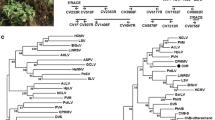Abstract
The genus Carlavirus (family Betaflexiviridae, order Tymovirales) currently includes 53 species recognized by the ICTV. The NCBI GenBank database has 43 full-length carlavirus genome sequences (7,890 to 9,073 nt). Surprisingly, the type species Carnation latent virus is not associated with a complete genome sequence of a carnation latent virus (CLV) isolate; GenBank only has accessions with 1313 or fewer nucleotides. The goal of this study was to determine the full-length genome sequence of CLV. Naturally infected greenhouse-grown ‘Kiwi Lace’ carnation plants that tested positive for CLV by ELISA and RT-PCR were used as source plants for high-throughput sequencing, completed by 5' and 3' RACE and validated by Sanger sequencing of CLV-specific RT-PCR-generated amplicons. The complete CLV-KL sequence (MN450069) was determined to be 8,513 nt in length. In pairwise analysis, the genome shares 40-46% identity with recognized carlaviruses and the six in silico-translated proteins have 15-62% amino acid sequence identity to their respective carlavirus orthologs. The CLV-KL coat protein shares 98.4% identity with the NCBI reference sequence CLV-UK. In phylogenetic analysis, CLV clusters with butterbur mosaic virus, coleus vein necrosis virus, and garlic common latent virus. This is the first report of the full genome sequence of an isolate of carnation latent virus, the type member of the genus Carlavirus.



Similar content being viewed by others
References
Kassanis B (1954) A virus latent in carnation and potato plants. Nature, London 173:1097–1098
Kassanis B (1955) Some properties of four viruses isolated from carnation plants. Ann Appl Biol 43:103–113
ICTV (International Committee on Taxonomy of Viruses) (1971) Virus taxonomy: the classification and nomenclature of viruses: 1971 Release. 1st Report (MSL #01). https://talk.ictvonline.org/taxonomy/p/taxonomy_releases. Accessed 24 Feb 2021
Brunt A, Crabtree K, Dallwitz M, Gibbs A, Watson L (1996) Viruses of Plants: Descriptions and Lists from the VIDE Database. 1484 pp. C.A.B. International, U.K
Adams MJ, Candresse T, Hammond J et al (2012) Betaflexiviridae. In: King AMQ, Lefkowitz E, Adams MJ, Carstens EB (eds) Virus taxonomy: Ninth report of the international committee on taxonomy of viruses. Elsevier, San Diego, pp 920–944
ICTV (International Committee on Taxonomy of Viruses) (2019) Virus taxonomy: the classification and nomenclature of viruses: 2019 Release. EC 51, Berlin, Germany, July 2019; Email ratification March 2020 (MSL #35). https://talk.ictvonline.org/taxonomy/p/taxonomy_releases. Accessed 24 Feb 2021
Jordan R, Guaragna MA (2002) Successful development of monoclonal antibodies to three carnation viruses using an admixture of only partially purified virus preparations as immunogen, and their use in virus diagnosis. Acta Hort 568:177–183
Bankevich A, Nurk S, Antipov D et al (2012) SPAdes: a new genome assembly algorithm and its applications to single-cell sequencing. J Comput Biol 19:455–477. https://doi.org/10.1089/cmb.2012.0021
Marchler-Bauer A, Bo Y, Han L et al (2016) CDD/SPARCLE: functional classification of proteins via subfamily domain architectures. Nucleic Acids Res 45:D200–D203
Mitchell AL, Attwood TK, Babbitt PC et al (2019) InterPro in 2019: improving coverage, classification and access to protein sequence annotations. Nucleic Acids Res 47(D1):D351–D360. https://doi.org/10.1093/nar/gky1100
Kumar S, Stecher G, Li M, Knyaz C, Tamura K (2018) MEGA X: molecular evolutionary genetics analysis across computing platforms. Mol Biol Evol 35:1547–1549
Jones DT, Taylor WR, Thornton JM (1992) The rapid generation of mutation data matrices from protein sequences. Comput Appl Biosci 8:275–282
Funding
This work was supported through USDA funding, Agricultural Research Service, Research Projects 8020-22000-042-00D and 8042-22000-302-00-D.
Author information
Authors and Affiliations
Corresponding author
Ethics declarations
Conflict of interest
The authors declare that they have no conflict of interest.
Research involving human participants or animals
This study did not include experiments with human participants or animals performed by any of the authors.
Additional information
Handling Editor: Stephen John Wylie.
Publisher's Note
Springer Nature remains neutral with regard to jurisdictional claims in published maps and institutional affiliations.
Supplementary Information
Below is the link to the electronic supplementary material.
Rights and permissions
About this article
Cite this article
Jordan, R., Korolev, E., Grinstead, S. et al. First complete genome sequence of carnation latent virus, the type member of the genus Carlavirus. Arch Virol 166, 1501–1505 (2021). https://doi.org/10.1007/s00705-021-04999-y
Received:
Accepted:
Published:
Issue Date:
DOI: https://doi.org/10.1007/s00705-021-04999-y




